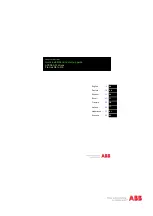
Installing the Inverter
26
2
Connect the other ends of the ground cables to the supply earth (ground) terminal
Note
•
200 V products require Class 3 grounding. Resistance to ground must be
≤
100 Ω.
•
400 V products require Special Class 3 grounding. Resistance to ground must be
≤
10 Ω.
Install ground connections for the inverter and the motor by following the correct specifications to
ensure safe and accurate operation. Using the inverter and the motor without the specified
grounding connections may result in electric shock.
This product can cause a D.C current in the protective earthing condcutor. If a RCD or
monitoring (RCM) device is used for protection, only RCD or RCM of Type B is allowed on
supply side of this product.
Step 3 Power Terminal Wiring
The following illustration shows the terminal layout on the power terminal block. Refer to the
detailed descriptions to understand the function and location of each terminal before making
wiring connections. Ensure that the cables selected meet or exceed the specifications in
•
Apply rated torques to the terminal screws. Loose screws may cause short circuits and
malfunctions. Tightening the screw too much may damage the terminals and cause short
circuits and malfuctions.
•
Use copper wires only with 600 V, 75
℃
rating for the power terminal wiring, and 300 V,
75
℃
rating for the control terminal wiring.
•
Power supply wirings must be connected to the R, S, and T terminals. Connecting them to
the U, V, W terminals causes internal damages to the inverter. Motor should be connected
to the U, V, and W Terminals. Arrangement of the phase sequence is not necessary.
Attention
•
Appliquer des couples de marche aux vis des bornes. Des vis desserrées peuvent
provoquer des courts-circuits et des dysfonctionnements. Ne pas trop serrer la vis, car
cela risque d‘endommager les bornes et de provoquer des courts-circuits et des
dysfonctionnements.
•
Utiliser uniquement des fils de cuivre avec une valeur nominale de 600 V, 90
℃
pour le
câblage de la borne d‘alimentation, et une valeur nominale de 300 V, 75
℃
pour le
câblage de la borne de commande.
Summary of Contents for H100
Page 14: ......
Page 18: ...Preparing the Installation 4 37 90 kW 3 Phase ...
Page 27: ...Preparing the Installation 13 ...
Page 47: ...33 Installing the Inverter ...
Page 48: ...Installing the Inverter 34 Input and Output Control Terminal Block Wiring Diagram ...
Page 61: ...47 Installing the Inverter ...
Page 71: ...Learning to Perform Basic Operations 57 ...
Page 88: ...Learning to Perform Basic Operations 74 ...
Page 103: ...89 Learning Basic Features Code Description V1 Quantizing ...
Page 129: ...115 Learning Basic Features ...
Page 140: ...Learning Basic Features 126 ...
Page 148: ...Learning Basic Features 134 ...
Page 171: ...157 Learning Advanced Features Deceleration dwell operation ...
Page 183: ...169 Learning Advanced Features ...
Page 184: ...Learning Advanced Features 170 PID Command Block ...
Page 185: ...171 Learning Advanced Features PID Feedback Block ...
Page 186: ...Learning Advanced Features 172 PID Output Block ...
Page 187: ...173 Learning Advanced Features PID Output Mode Block ...
Page 197: ...183 Learning Advanced Features ...
Page 201: ...187 Learning Advanced Features Code Description 100 EPID1 Control block ...
Page 202: ...Learning Advanced Features 188 EPID2 Control block ...
Page 237: ...223 Learning Advanced Features Time Period Schedule AP3 38 Except3 Day 01 01 ...
Page 244: ...Learning Advanced Features 230 ...
Page 259: ...245 Learning Advanced Features Code Description Code Description Volt ...
Page 362: ...Learning Protection Features 348 ...
Page 415: ...401 RS 485 Communication Features Item Standards Parity check None ...
Page 524: ...Table of Functions 510 ...
Page 533: ...Table of Functions 519 ...
Page 547: ...533 Troubleshooting ...
Page 585: ...Technical Specification 571 ...
Page 594: ...580 ...
Page 595: ...581 ...
Page 596: ...582 ...
















































